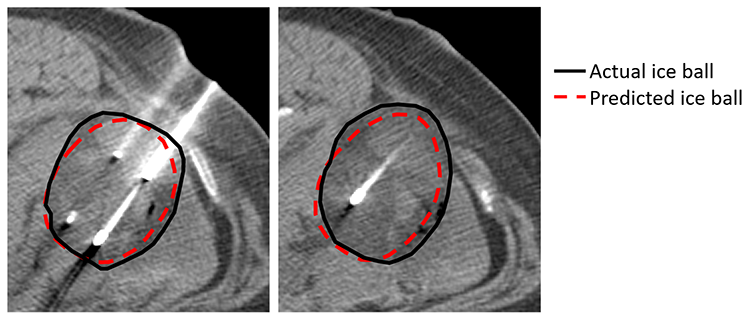

Use the cryoablation planning tool
|
View the:
Paper (preprint) |
Boas FE, Srimathveeravalli G, Kaye EA, Durack JC, Erinjeri JP, Ziv E, Maybody M, Yarmohammadi H, Solomon SB. (2017) "Development of a searchable database of cryoablation simulations for use in treatment planning." Cardiovascular and Interventional Radiology. 40(5): 761-8. Boas FE, Srimathveeravalli G, Kaye E, Durack JC, Erinjeri JP, Ziv E, Maybody M, Yarmohammadi H, Solomon SB. "Development of a searchable database of cryoablation simulations, for use in treatment planning." JVIR 27(3): S31. Oral presentation at SIR, Vancouver, 2016-04-03. Abstract Purpose: To create and validate a planning tool for multiple-probe cryoablation, using simulations of ice ball size and shape for various ablation probe configurations, ablation times, and types of tissue ablated. Materials and methods: Ice ball size and shape was simulated using the Pennes bioheat equation. 5670 different cryoablation procedures were simulated, using 1-6 cryoablation probes and 1-2 cm spacing between probes. The resulting ice ball was measured along three perpendicular axes and recorded in a database. Simulated ice ball sizes were compared to gel experiments (26 measurements) and clinical cryoablation cases (42 measurements). The clinical cryoablation measurements were obtained from a HIPAA-compliant retrospective review of kidney and liver cryoablation procedures between January 2015 and February 2016. Finally, we created a web-based cryoablation planning tool, which uses the cryoablation simulation database to look up the probe spacing and ablation time that produces the desired ice ball shape and dimensions. Results: Average absolute error between the simulated and experimentally measured ice balls was 1 mm in gel experiments, and 4 mm in clinical cryoablation cases. The simulations accurately predicted the degree of synergy in multiple-probe ablations. The cryoablation simulation database covers a wide range of ice ball sizes and shapes up to 9.8 cm. Conclusion: Cryoablation simulations accurately predict the ice ball size in multiple-probe ablations. The cryoablation database can be used to plan ablation procedures: given the desired ice ball size and shape, it will find the number and type of probes, probe configuration and spacing, and ablation time required.
|